Reverse Sear Prime Rib (Mouthwatering!)
This prime rib recipe uses the reverse-sear method to create mouthwatering, medium-rare, tender meat throughout the entire roast. It doesn’t get better than that.
Prime rib is one of my top 3 favorite meals on the planet. It’s the king of holiday roasts. It’s very expensive, but worth it for a special occasion if you can splurge.
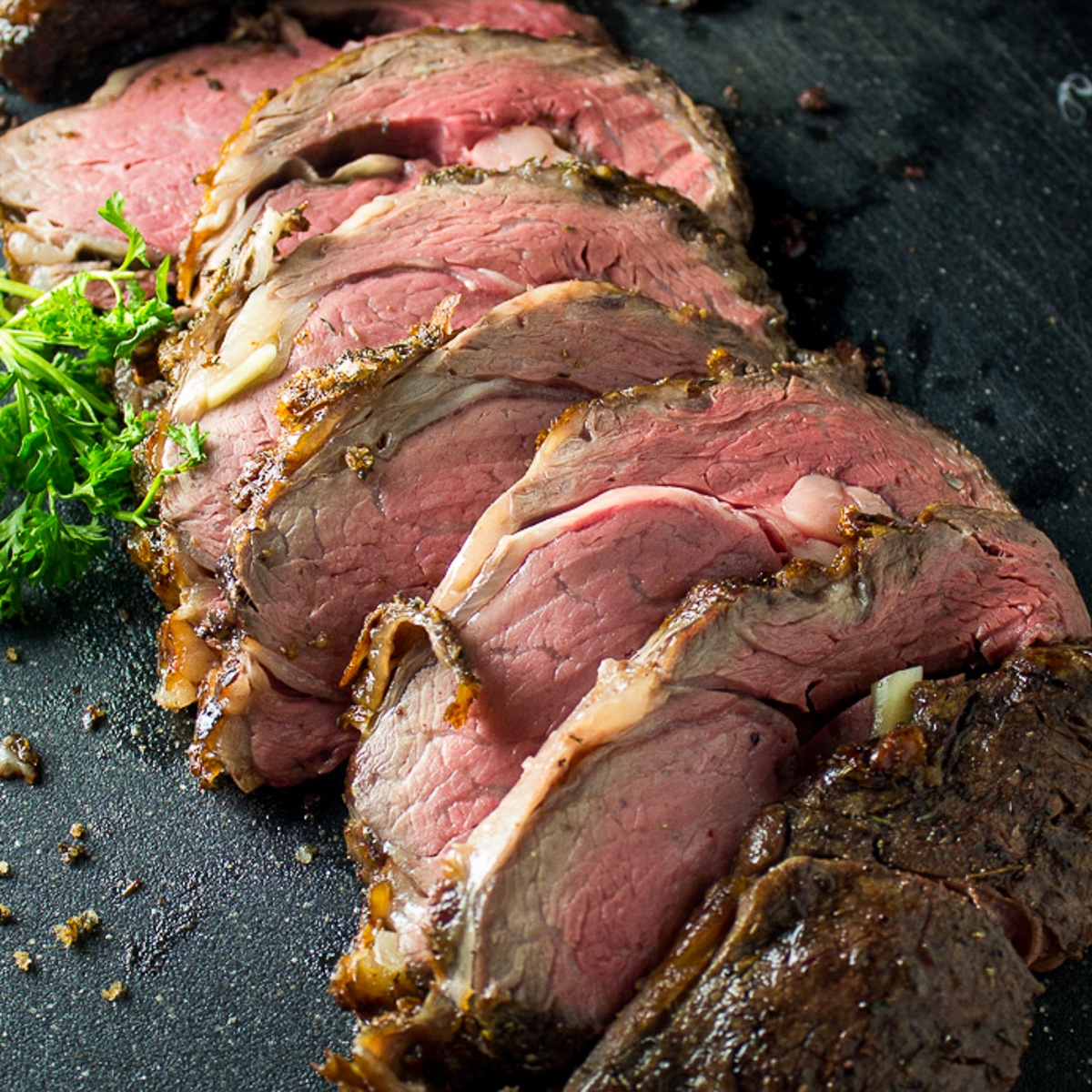
Years ago, I found a new favorite way to make prime rib – the reverse sear method. It simply makes the best prime rib ever.
3 steps for the reverse sear method:
- Low temperature: Initially roast the beef in the oven at a very low oven temperature.
- Rest the beef for 20-90 minutes out of the oven, and then
- High temperature: Blast the beef at high heat in the oven for the final 8-12 minutes, depending on the size of the roast.
What to expect with a reverse sear method
This reverse sear prime rib recipe is as close to a perfect prime rib as you can get. Here’s why:
The meat is cooked evenly throughout the roast – to the level of doneness you like – with a beautifully browned crust and little to no gray edge below the surface.
You can make the roast more than an hour ahead and do the last step of high-heat roasting right before serving.
There is no need to rest the meat in the last step. This increases your chance of getting warm meat to your guests – a huge plus for anyone who agonizes about keep a prime rib warm without overcooking it (like me). If you’re interested, here’s more on how to keep foods warm.
The long roasting time can be seen as a downside, but if you’re having a dinner party and have lots of other things to do while the beef is roasting (who doesn’t), it makes a lot of sense.
Ingredients – tailored to your taste
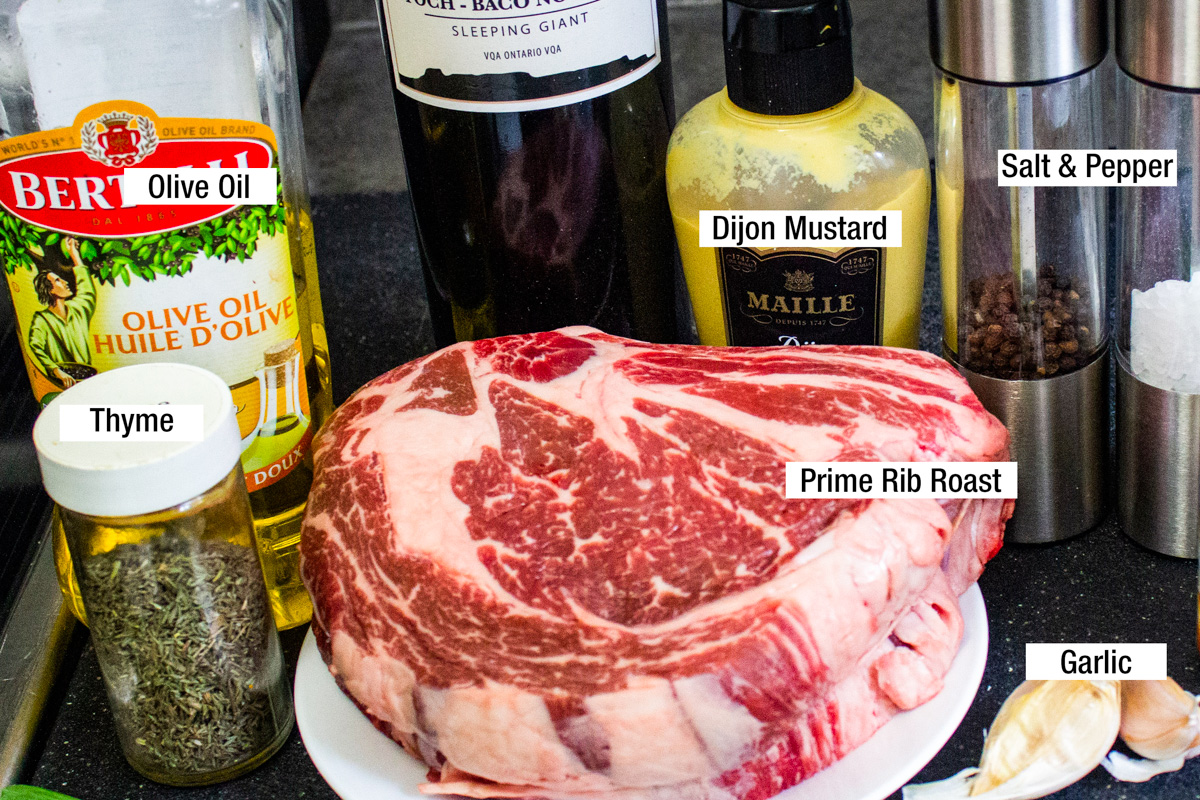
Prime rib: is a high-end cut of beef that has considerable marbling (fat) which adds amazing flavor. The bone-in cut is called a standing rib roast. The boneless cut is called a ribeye roast or boneless prime rib. The “prime” on the package is a USDA designation that tells you the meat is of high quality.
Seasoning: Many chefs like to let the flavor of prime rib shine through and only use salt and pepper as seasoning. I’ve always added the garlic slivers (which in my opinion add sensational flavor), a bit of mustard and sometimes a sprinkle of thyme.
Pre-seasoning option: To add even more flavor and a crustier darker exterior, there’s an optional salting step you can try a day or two ahead. The instructions are in the recipe card.
Exterior Crust: You can also dry the roast in the fridge without the salt. This won’t add flavor, but it will give you the crustier exterior.
Step by step instructions
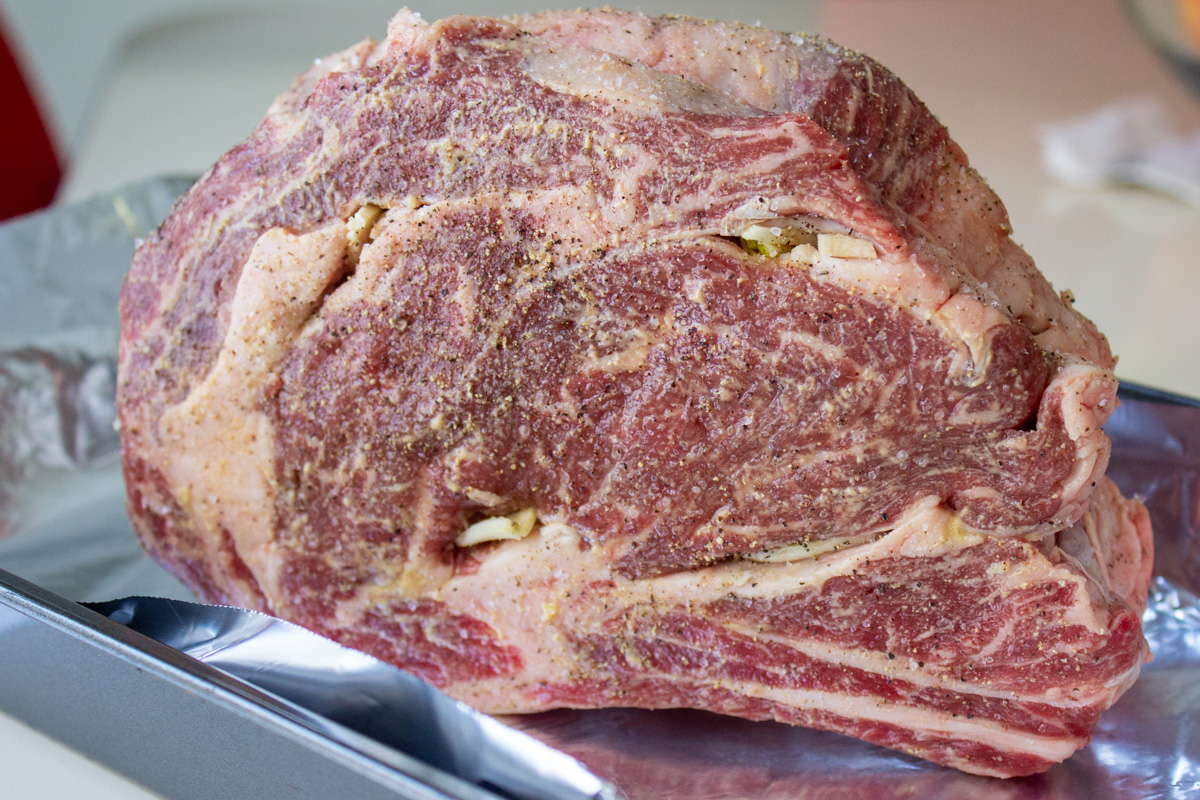
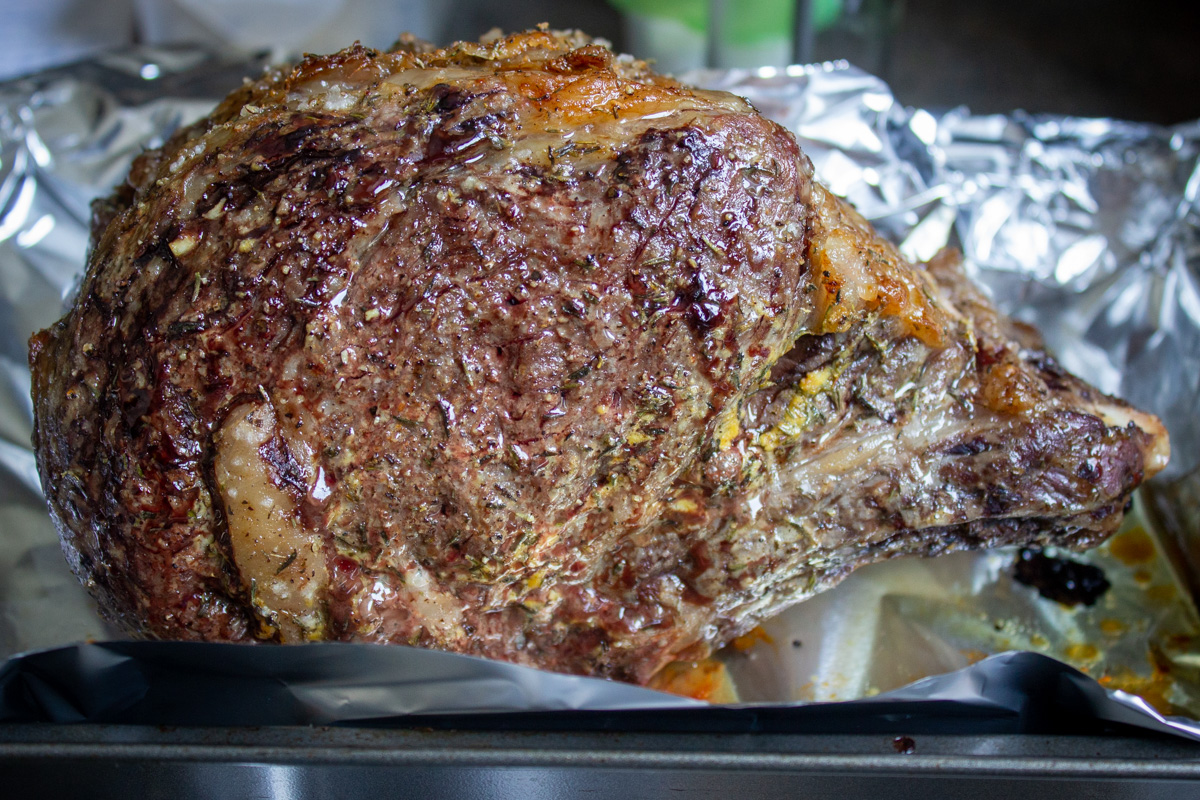
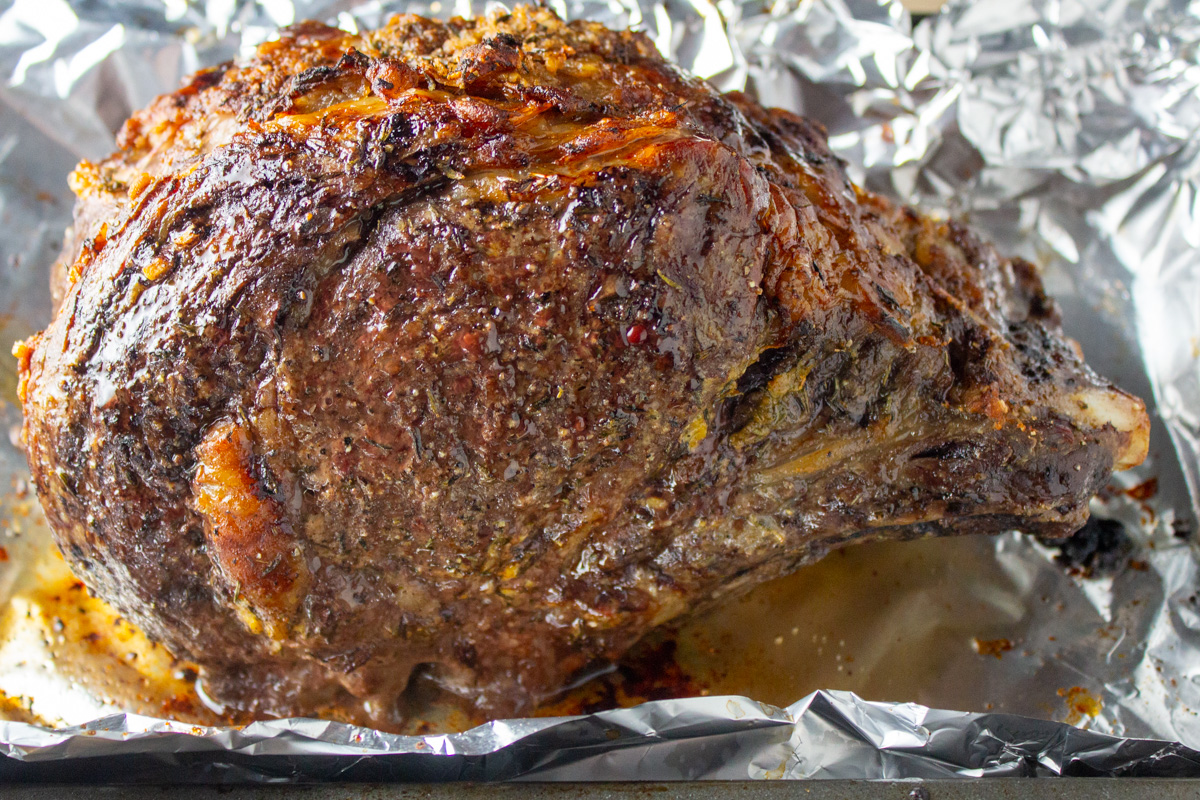
Step 3: Finish roast for 6-12 minutes in a hot oven at 500F/260C. The internal temperature will reach 130F/54.4C with an instant-read thermometer.
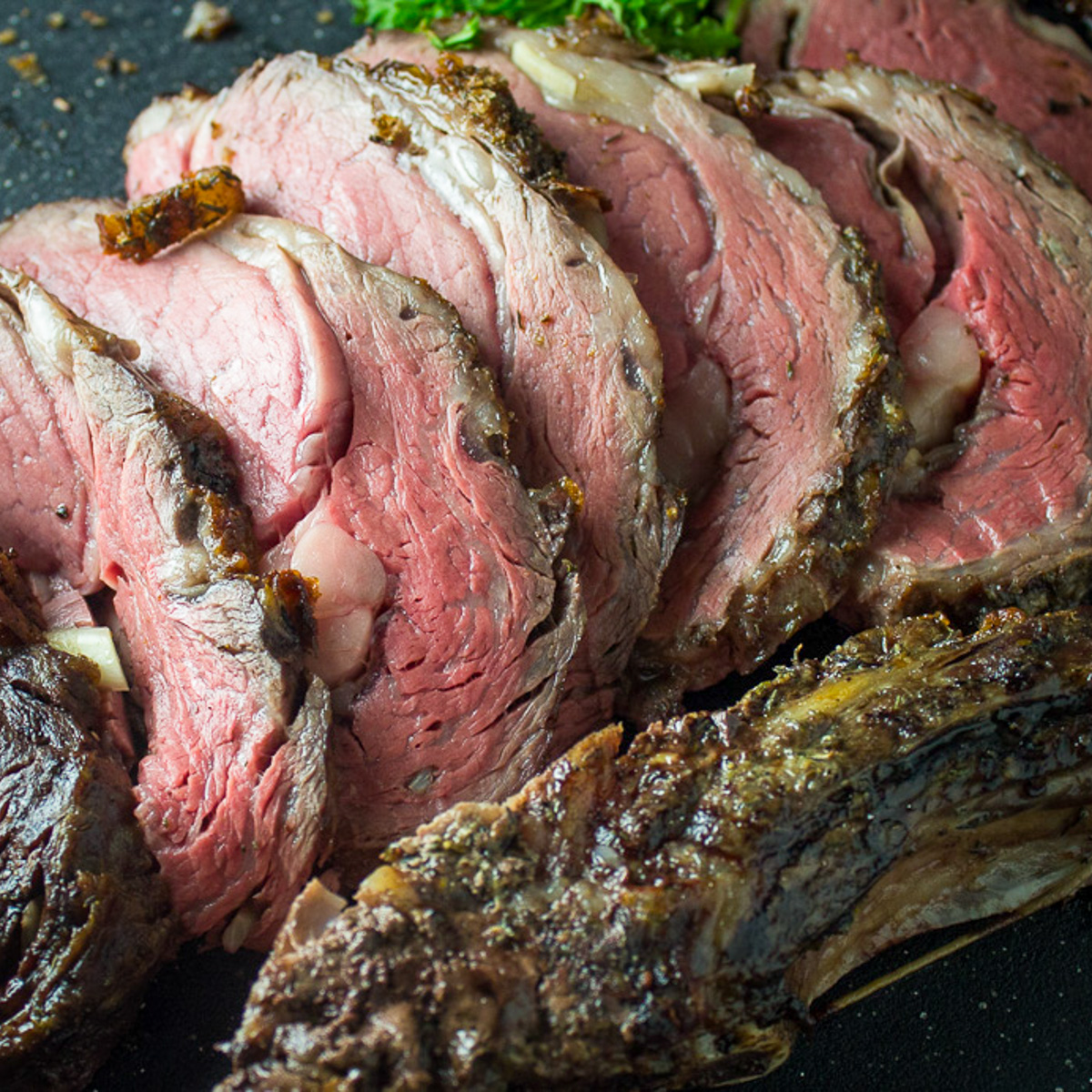
Recipe FAQs
The best way to get an outstanding end result is to begin with an outstanding piece of meat. Look for USDA Prime, AAA or Certified Angus Beef (best and most expensive). ‘USDA Choice’ – is not as good as Prime (a bit less marbled), but still good. ‘Select’ will be cheaper, less juicy and less tender.
Opinions vary. Food Network and America’s Test Kitchen suggest buying the first cut (also called the small end or the loin end). Ask for ribs 10-12. This cut is generally regarded as the best cut because it contains the large, single rib-eye muscle, has less connective tissue than the second cut and therefore is more uniform and tender.
Chef Steps recommends the second cut, ribs 6-9, as it has more fat and flavor as well as a larger and very tender cap of meat on the top. I am in this camp.
The classic prime rib roast presentation is “with bone”. It’s pretty, very flavorful and the bones help insulate the meat while cooking for a juicy tender result. Some people love the bones!
A prime roast without the bone is called a ribeye roast or boneless prime rib. The advantages of this kind is more even seasoning and ease of carving. Both cuts are excellent. Some chefs cut the bones off the prime rib, season the roast, then tie the ribs back on.
1. Regular oven roasting (typically the high-low heat method)
2. Slow roasting
3. Sous vide method – try our sous vide prime rib with this method, and
4. Reverse sear method. This method may not be as popular, but it definitely should be. I discovered this method from author and chef J. Kenji Lopez-Alt’s Serious Eats.
What to serve with prime rib
My favorite side dishes with prime rib are potatoes and beef gravy.
Any of these potato dishes are great with roast beef: basic mashed potatoes, fried potato and onions, best instant potatoes and carrots or crispy oven roasted potatoes.
Other great sides are Yorkshire Pudding, Parmesan Roasted Cauliflower, Green Beans with Panko Crumbs, Marinated Tomato Salad , Festive Winter Salad and Roasted Honey-Glazed Carrots.
Make Ahead, Store, Reheat
The reverse sear method allows you to make the roast 30-90 minutes ahead. The final sear at high heat should be completed 6-15 minutes before serving, depending on the size of the roast.
Store leftovers in an airtight container for 2-3 days.
To reheat prime rib, it’s best to go low and slow (the microwave is not the best option). America’s Test Kitchen suggests the oven method for reheating: See recipe notes.
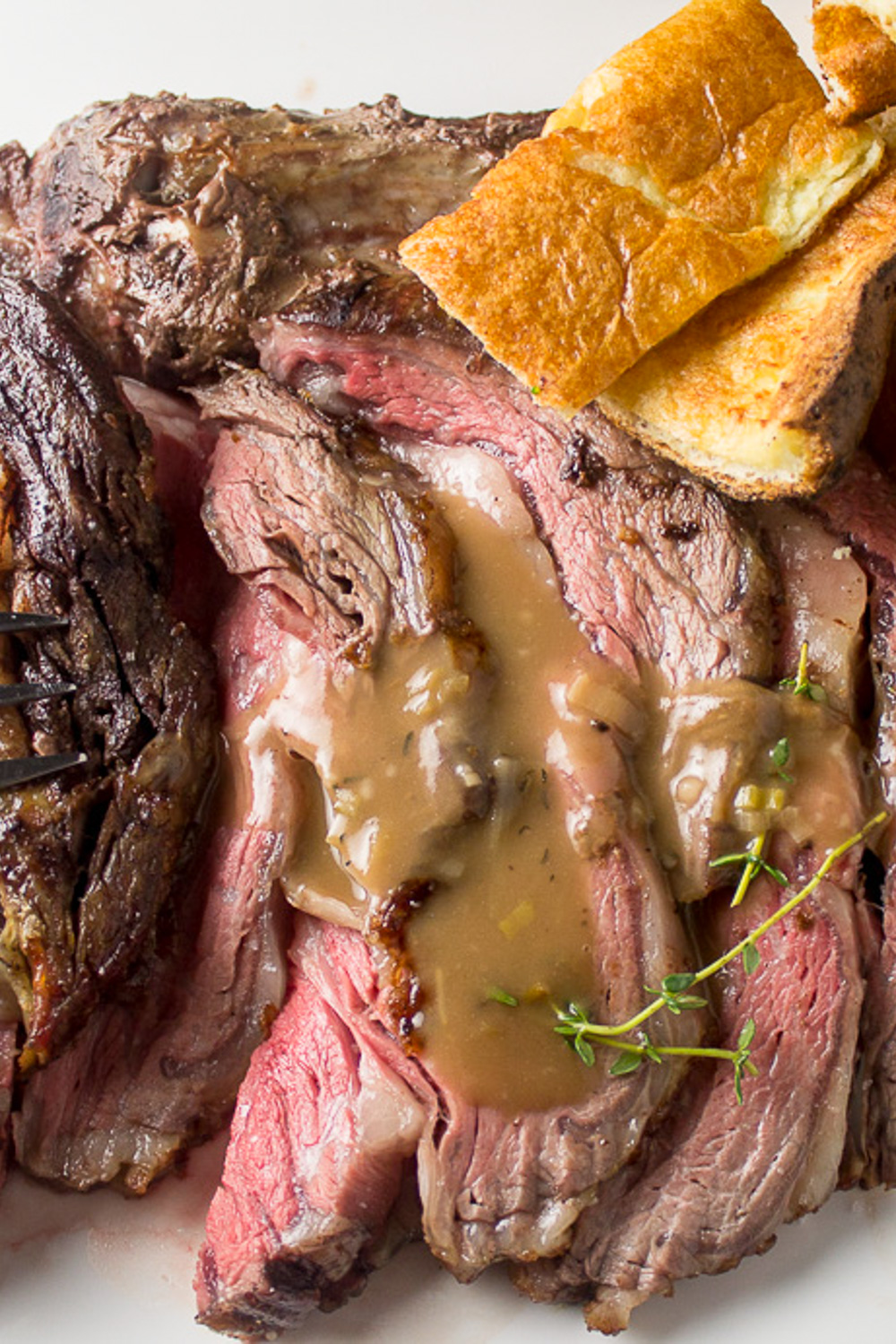
Love the reverse sear method? Then try our boneless pork roast with gravy (reverse sear).
Instead of beef, serve the prime rib of lamb with a rack of lamb on the grill. Or the prime rib of pork with a rack of pork. Delish.
If you like this recipe, please leave a 5 star rating 🌟🌟🌟🌟🌟in the recipe card below. And if you REALLY like it, consider a review in the comments. Thanks very much!
Reverse Sear Prime Rib (Mouthwatering)
Equipment
- instant read thermometer or probe
Ingredients
- 3 pounds (1.36 kg) prime rib of beef, well marbled, Note 1 (2 ribs or bones)
- 2 garlic cloves, sliced into thin slivers
- Optional: 2 tsp Dijon mustard and fresh or dry thyme
- kosher salt and black pepper
Instructions
- OPTIONAL PRE-SEASONING the day before. Note 2
- HEAT OVEN to 250F/121C.
- PREPARE ROAST: Pat roast dry with paper towel. Insert garlic slivers into roast all over between meat and fat (separate with fingers and slip in garlic). Leave the fat cap on the top of the meat for great flavor. If using Dijon, smear it all over roast. Season roast liberally with kosher salt and black pepper. Sprinkle on thyme if using. Place roast bone side down in shallow pan lined with foil (for easier clean up). If you have a temperature probe, insert it in the center of the roast. If not use an instant-read thermometer.
- START ROASTING AT LOW TEMP: Roast in oven, fat side up, at 250F/121C for about 2 to 2 1/4 hours or until internal temperature reaches 120F/49C for medium rare on instant thermometer (you'll be cooking it longer later on). Or 130F/54.4C for medium.
- REST ROAST: Remove roast, cover loosely with aluminum foil and let it rest for at least 30 minutes and up to 90 minutes.
- FINISH ROASTING AT HIGH TEMP: While roast is resting, increase oven temperature to 500F/260C. 10 minutes before you're ready to serve, place roast in hot oven. Roast for 6-10 minutes (or 5 minutes longer if roast is bigger) until exterior browns nicely. Insert meat thermometer to check temperature of meat – it should rise to 130F/54.4C for medium rare. Or 140F/60C for medium measured with an instant-read thermometer. Note 3 for internal temperatures the way your like your beef cooked.
- SLICE AND SERVE: On cutting board, turn roast on side and slice off bones. Then turn meat, cut side down, on board and slice. Remove garlic slivers. Serve immediately with gravy (Note 4) or au jus.
Video
Recipe Notes
- What is a prime rib cut: Look for USDA Prime on the package. USDA Choice is not as high-end as Prime, but it’s still good. Other markings (in Canada, for example) are AAA and Certified Angus Beef. Select is less tender.
- How much meat to buy per person:
- By rib: Generally figure 1 rib will serve 2 people. 4-5 ribs will serve 8-10 people. 2 ribs will serve 4-5 people
- By weight: For a bone-in roast, figure about 1 pound/0.54 kg per person. For a boneless beef rib roast, figure a bit more than 1/2 pound/0.28 kg per person.
- How much meat to buy per person:
- Pre-seasoning option: To add even more flavor and a crustier darker exterior, dry brine the roast. A day or two ahead, pat the roast dry with a paper towel, salt it, then place it in the fridge on a rack, uncovered, to dry out and allow the flavor of the meat to develop. Bring the roast to room temperature (2 hours) before roasting. I often skip the dry brine since I always serve my prime rib with gravy which also adds to the flavor. Alternatively, you can also dry the roast in the fridge without the salt. This won’t add flavor, but it will give you the crustier exterior.
- Doneness (internal temperature). Here’s how What’s Cooking America measures doneness using an instant-read thermometer:
- Rare – 120 to 125 degrees F (49-51.7C) – center is bright red, pinkish toward the exterior portion
- Medium Rare – 130 to 135 degrees F (54-57C) – center is very pink, slightly brown ring at the edge
- Medium – 140 to 145 degrees F (60-63C) – center is light pink meat, small outer portion is brown
- Medium Well – 150 to 155 degrees F (65.6-68C) – not pink
- Well Done – 160 degrees F (71C) and above
- To make gravy, check out our recipe for beef gravy without drippings (but INSTEAD of butter or oil, use the fat beef drippings from the roast if you like and make it while the beef is resting)
- Make ahead/Store/Reheat:
- You can make the roast up to 100 minutes ahead of serving.
- Store leftovers in an airtight container for 2-3 days.
-
To reheat prime rib, it’s best to go low and slow (the microwave is not the best option). America’s Test Kitchen suggests the oven method for reheating:
- Place roast, uncovered, on a wire rack placed in rimmed baking pan. Place the pan on the middle rack in a 250F/121C oven.
- Roast until the meat reaches a temperature of 120F/49C (1 to 1 1/2 hours depending on the size of your roast). Pat surface dry with paper towels.

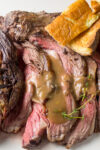
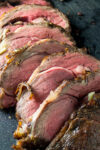
Reverse sear is awesome. I salted and stored in the fridge for a darker crust and awesome flavor.
Resting time is perfect time to roast veggies and a pan of Gratin potatoes.
Pan drippings make au jus for the win!
Sounds absolutely delicious! One of my all time favorite dinners. Glad you liked it. Thanks so much for taking the time to leave a comment Chef 🙂
I’ve view making prime rib my whole life and I can honestly say this is a superior method for preparing it perfectly. The smell of the roast cooking during the afternoon was intoxicating. The resting period allowed for high temperature roasting of vegetables and then the finishing of the beef was super fast easy and effective. The meat was incredibly tender! Thank you!
Glad it worked so well Fran! It’s one of my favorite recipes in the world. I agree about the smell – heavenly! Thanks for taking the time to leave a comment.
so any idea on a 6 pound boneless for time ?
Hi Sandi, A meat thermometer is your best friend here. And the timing will depend on how you like it. If you are aiming for medium rare, I’d say about 3 hours (maybe a bit longer), but I would start checking at least 30 minutes before. Ovens always differ. Hope that helps.
The timing and temperature, mostly temperature, never worked out. Took 40 minutes to get to 128 degrees. Not sure I’ll try this type of roast again. First one I made this way took 6 hours to get to 140 degrees. Not big roasts either. Not t a problem with other items just rub roasts.
Sorry to hear that Dawn. Could the problem be your oven temperature? Most ovens are not accurate. It may be worth checking it with a cheap oven thermometer if you think that might be the issue. Although that’s quite a swing you noted. 40 minutes and 6 hours. And you said other items work ok. Puzzling. 🤔
Tried this recipe for Christmas Eve dinner. Absolutely wonderful. I used a “Meater” thermometer which took out all the guess work. Cooked a 6 lb. bone in. Took out at 3 hrs 15 min with an internal temp of 128 dF. Let rest for 90 minutes. Internat temp was at 132 dF when I put the roast in the 500 dF oven. Seared for 10 min. Let rest for five minutes, sliced and served. By far the best recipe I have used.
Thak you for sharing.
Thank you Norm. Sounds perfect! I agree that a thermometer or probe is an essential tool to take out the guesswork as you said.
When the roast is in the oven at 250° should it be covered or lid off?
For both the low heat and the high heat parts, you don’t need a lid. Lid off. Good luck 🙂
I will for now on use the reverse sear method! I did my original cooking in the electric roaster. An 8 lb. (4 bone) prime rib got up to 130 in just under 3 hours. I’m the only one that likes it red, so this temp worked perfectly for us! I tented it for 90 minutes while I cooked the sides. I could have been doing that while the meat was in the roaster, however, we were waiting on fo!ks. This method gives much more flexibility, and turned out perfectly! Thanks for the great recipe.
Hi Robi. Agree! The reverse sear method is sensational for a prime rib when you’re having company. Thanks so much for taking the time to leave a comment.
A very easy recipe to follow; guaranteed to give mouth watering results! We ate this at our friend’s house and decided to make it too. We really enjoyed.
So glad you enjoyed it. Thanks for leaving a comment.